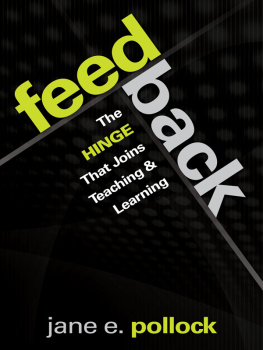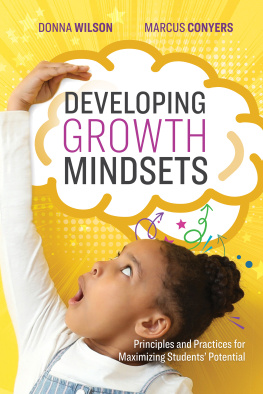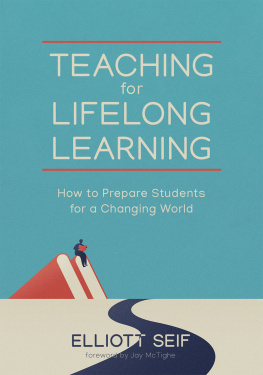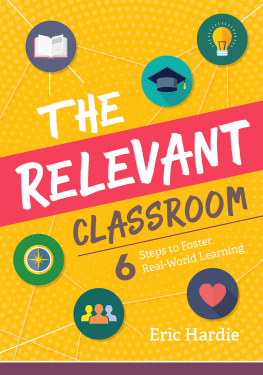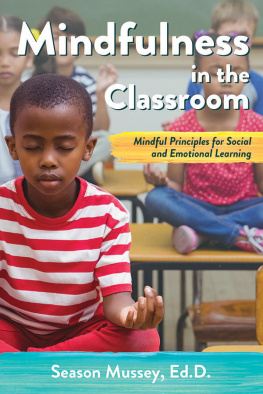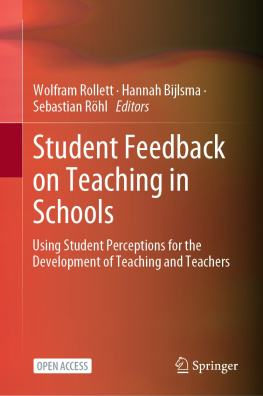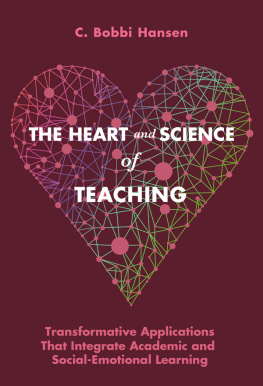feed back
For my boys Sam and Zach
feed back
The
HINGE
That Joins
Teaching &
Learning
jane e. pollock


FOR INFORMATION:
Corwin
A SAGE Company
2455 Teller Road
Thousand Oaks, California 91320
(800) 233-9936
Fax: (800) 417-2466
www.corwin.com
SAGE Publications Ltd.
1 Olivers Yard
55 City Road
London EC1Y 1SP
United Kingdom
SAGE Publications India Pvt. Ltd.
B 1/I 1 Mohan Cooperative Industrial Area
Mathura Road, New Delhi 110 044
India
SAGE Publications Asia-Pacific Pte. Ltd.
33 Pekin Street #02-01
Far East Square
Singapore 048763
Acquisitions Editor: Arnis Burvikovs
Associate Editor: Desire A. Bartlett
Editorial Assistant: Kimberly Greenberg
Production Editor: Cassandra Margaret Seibel
Copy Editor: Trey Thoelcke
Typesetter: C&M Digitals (P) Ltd.
Proofreader: Jenifer Kooiman
Indexer: Diggs Publishing Services
Cover Designer: Scott Van Atta
Permissions Editor: Adele Hutchinson
Copyright 2012 by Corwin
All rights reserved. No part of this book may be reproduced or utilized in any form or by any means, electronic or mechanical, including photocopying, recording, or by any information storage and retrieval system, without permission in writing from the publisher.
Printed in the United States of America
Library of Congress Cataloging-in-Publication Data
Pollock, Jane E., 1958
Feedback: the hinge that joins teaching and learning/Jane Pollock.
p. cm.
Includes bibliographical references and index.
ISBN 978-1-4129-9743-0 (pbk.)
1. Teacher-student relationships.
2. Communication in education.
3. Feedback (Psychology) I. Title.
LB1033.P64 2012
371.1022dc23 2011036338
This book is printed on acid-free paper
11 12 13 14 15 10 9 8 7 6 5 4 3 2 1
CONTENTS

PREFACE

B en Boggs, a biology teacher in Tennessee, tells me that he thinks most teachers today are frustrated with the very same issue: the unmotivated students in every class. Sounding a bit discouraged, he observes that there seem to be about five students in any class any day just not willing to engage in the lesson even though they have the ability. Engagement means achievement, he says.
Adrienne Braxton, an elementary teacher in Kentucky, comments that she used to spend so much time encouraging students to participate that she felt like she barely had time to teach. Honestly, I felt as though I tried everything to get students to take out their materials, get focused and participate, and still some of the students were acting disengaged.
Darlene Markle, a middle school principal in Wisconsin, tells me that her staff has read, workshopped, and implemented everything. Two years ago we spoke about it and she told me she believed she could do just about anything as a principal, but felt stymied when observing hard-working teachers in classrooms facing a number of students who just did not seem to care enough about the lessons to do assignments or do them well. Teachers worked harder, students may even have worked harder, but any day in any classroom in their building you could find some middle school students who disengaged during the lesson.
Some students seem uninspired by daily instruction, even though they have access to better technology, facilities, and materials than every generation of children before them. Teachers at all grade levels and across subject areas comment with dismay that some students choose not to participate in the learning.
During my career, I have spent much of my time working side-by-side with teachers as they plan instruction and with principals observing and giving feedback to teachers about improving learning. Teachers can get remarkably enthusiastic about trying new techniques, which makes the work fun as well as satisfying. But when I started to spend more time in classrooms with the teachers observing their delivery of the lessons we had planned, I began to notice that teachers used the new techniques we talked about and planned for in the lesson, but not all of the students used them. Some students did, but some did not.
Take a basic example like using a graphic organizer. In a history class, the teacher projected words on the board and asked students to work together to draw a flowchart connecting the vocabulary. In a class of twenty-eight students, one student did not even take out a piece of paper. After about three minutes, two students stopped writing but did not disrupt any other students. A student quietly put her head on her desk. In five minutes, three other students had attempted to fill in the organizer, but did not complete the task. They sat in silence. The teacher was busy. Having taken attendance, he walked over to one pair of students, intending, I believe, to make a quick tour of the class, but he stopped to help them. Noting the time, the teacher returned to the front of the room to talk about the words while drawing the flowchart on the board. Most of the students copied what he wrote on the board, or added to their own charts. The five or six students never really became engaged, but never disrupted the class; they just stared ahead, watching the teacher.
This book is about how to change engagement in classrooms like this one. A month after I watched that history class and worked with the teacher on techniques to engage students, I observed again. Every student participated from bell to bell. Ask the teacher and he will tell you that it was a challenge for him to change a few of his teaching habits, but it was worth it to see students be more interactive in class and perform better on assignments and assessments.
As I observed teachers planning, teachers teaching, supervisors observing, and learners learning, I kept asking myself whether there was a single criterion common to all of them that could literally open a floodgate of learning. And, if so, could we replicate it at any level, in any subject area, and in fact, any time a person wanted to learn something new or learn better? Unlike other best practices books or reports about reform, this book draws upon publications in other fields where becoming aware of and changing a single factor results in sustained gains or improvements.
Many of us have read from the genre of books that includes The Tipping Point, by Malcolm Gladwell (2002), but they did not help us explain increasing student performance in schools, because a bottom line in business is not the same as personal achievement in schools. In business, the term tipping point is used to indicate a situation or episode that dramatically increases a product sale. Stories about Pet Rocks, Hush Puppies suede shoes, Beanie Babies, and the Boston Red Sox winning the World Series are tales of how little things can make big things happen. In schools, little things should be able to make big things happen, too.
Research shows that the factor to advance student engagement and achievement is not just teaching, nor just learning, but interlocking the two. A hinge is the device that allows two sides to swing relative to each other, and feedback seems to be a hinge that allows for the transfer of information from the teacher to the student and back to the teacher again. If we look at learning research, we find that feedback connects students to teachers in a way that acts as a hinge, and the result is accelerated productivity and increased achievement.
Next page
